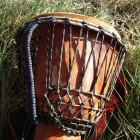I compiled the rhythms in the first Roots Jam book (1996) only five years into my own drum journey. I hit upon a notation method that could help me understand the timing structure of the many new rhythms I was learning, dividing the standard musical bar into visible divisions where the actual beats landed. I also wanted a form of notation which could easily be communicated in text and by email. The result was the method appearing in the book, like this:

Besides the timing system, I needed a way to indicate both types of beat (bass, tone, slap) and choice of hand (right or left). Babatunde Olatunji’s teaching method, sounding the notes as Gun, Dun, go, do, Pa Ta, provided a useful oral dimension to the drum vocabulary, represented by the shorthand G, D, g, d, P, T. So the example above can be easily read and played while speaking: Gun, Dun, go do Pa Ta.
For later volumes of the Roots Jam series, I adopted a 2-dimensional visual grid system, called box notation. The advantage here is that scanning down the page, to compare rhythm variations or separate instrument parts in an ensemble composition, you can see at a glance where beats line up and where they are offset.

Along the way, I have explored new territories in drum language, with an extensive Afro-Latin collection in Roots Jam 2 (transposing conga beats to djembe); complete arrangements for African dance, with traditional solos, along with original compositions, in Roots Jam 3; and a segue into samba, ballet-style dununs, Garafuna beats, and even tabla rhythms and melodic scales, in Roots Jam 4.
Note: The four volumes of the Roots Jam series are only sequential in that they have grown with the scope of my own learning. Each volume contains material appropriate for any level, from beginner to accomplished soloist.

Besides compiling and arranging rhythms for learning, study and practice, I have wanted to share tips and pointers, insights and lessons from my own experience in drum groups and performance (now three decades long!), to help you on your drummer’s path. These ingredients, covering everything from technique to etiquette and attitude, are also layered in the Roots Jam mix, both for flavor and for healing properties.
The other element added after the publication of Roots Jam 1 is audio and video. There are 28 rudimentary live audio tracks to demonstrate rhythm patterns in Roots Jam 2. The Roots Jam 3 audio collection instead uses Percussion Studio software to build complete arrangements (16 traditional and 27 original) for all the rhythms (the individual beats are live drum samples, but they are pieced together digitally). The written and audio rhythm lessons are now supplemented by free video lessons on YouTube (http://youtube.com/user/nowickg), with separate playlists for djembe (http://bit.ly/1AsaBG1) and dunun (http://bit.ly/2qERhuJ) rhythms.
Finally, a note about format and availability for the above resources. Links for all formats and options appear on a single order page at DjembeRhythms.com:
http://djemberhythms.com/books/order-roots-jam-drum-rhythm-books/
Full size printed books (8.5 X 11 inch) are available from Amazon, along with ebooks for Kindle that scale from the original PDF layout. You can also order ebooks (PDF files), along with all the MP3 audio files, from the DjembeRhythms.com order page, either a la carte or in budget-price combo bundles.
If you’ve joined my mailing list, I will keep you updated on any new material or discount offers, along with free bonus material. To sign up, go to http://djemberhythms.com/sign-up-to-newsletter/
Happy drumming!


